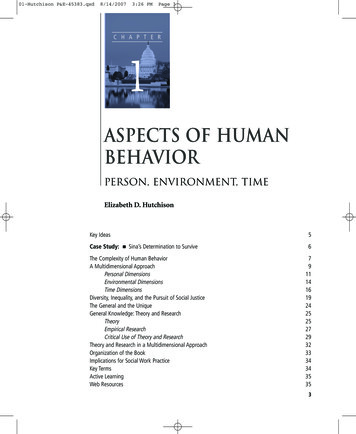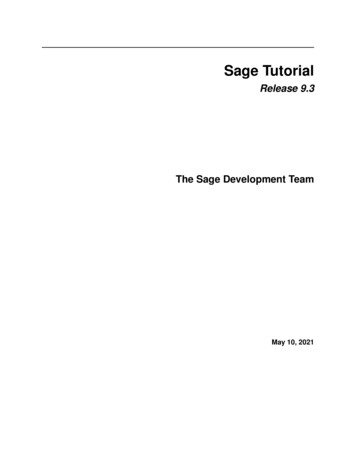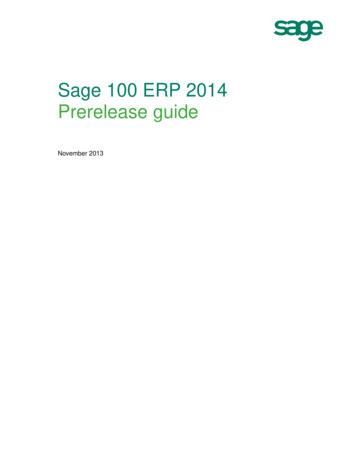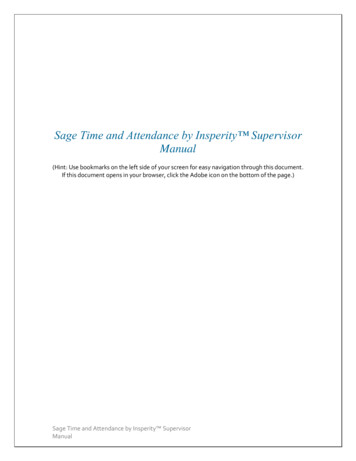
Transcription
01-Hutchison P&E-45383.qxd8/14/20073:26 PMPage 3C H A P T E R1ASPECTS OF HUMANBEHAVIORPerson, Environment, TimeElizabeth D. HutchisonKey IdeasCase Study:5 Sina’s Determination to SurviveThe Complexity of Human BehaviorA Multidimensional ApproachPersonal DimensionsEnvironmental DimensionsTime DimensionsDiversity, Inequality, and the Pursuit of Social JusticeThe General and the UniqueGeneral Knowledge: Theory and ResearchTheoryEmpirical ResearchCritical Use of Theory and ResearchTheory and Research in a Multidimensional ApproachOrganization of the BookImplications for Social Work PracticeKey TermsActive LearningWeb Resources6791114161924252527293233343435353
01-Hutchison P&E-45383.qxd8/14/20073:26 PMPage 4
01-Hutchison P&E-45383.qxd8/14/20073:26 PMPage 5Chapter 1 Aspects of Human Behavior What is it about people, environments, and time that social workers need to understand? Why is it important for social workers to understand the roles that diversity and inequality playin human behavior?KEY IDEASAs you read this chapter, take note of these central ideas:1. This book provides a multidimensional way of thinking about human behavior in termsof changing configurations of persons and environments.2. Although person, environment, and time are inseparable, we can focus on them separately by thinking about the relevant dimensions of each.3. Relevant personal dimensions include the biological, the psychological, and the spiritual.4. Nine dimensions of environment that have relevance for social work are the physicalenvironment, culture, social institutions and social structure, dyads, families, smallgroups, formal organizations, communities, and social movements. These dimensionshave been studied separately, but they are neither mutually exclusive nor hierarchicallyordered.5. Special attention should be paid to diversity, power relations, and patterns in opportunities and constraints.6. General knowledge, as well as knowledge about the unique situation, is necessary foreffective social work practice.7. We use a number of ways to try to understand human behavior, but we draw heavily ontwo interrelated rigorous and systematic ways of building general knowledge: theory andempirical research.5
01-Hutchison P&E-45383.qxd68/14/20073:26 PMPage 6A MULTIDIMENSIONAL APPROACH FOR MULTIFACETED SOCIAL WORKCase StudySina’s Determination to SurviveSina grew up in a suburb of Phnom Penh, Cambodia. Because there were so many children in the familyinto which she was born, Sina and her two younger sisters were sent to be raised by relatives who livednearby and who could not have children of their own. Sina had a happy childhood with these relatives andthinks of them as her parents. (Therefore, I will refer to them as her parents.) Sina’s parents were merchants,and she worked in the store with them. Her marriage at the age of 16 was arranged. Both Sina and herhusband completed the equivalent of our high school education and were considered, in Cambodia, to bequite well educated. Sina’s husband worked as a mechanic until they left the Phnom Penh area.When the Khmer Rouge soldiers came to the outskirts of Phnom Penh in April 1975, Sina had no ideathat her pleasant life was about to be so radically changed. The soldiers spread the word that the Americanswere planning to bomb Phnom Penh and that everyone had to leave the area for a little while. The wholecity was quickly evacuated. Sina, who was pregnant, headed for the countryside with her husband, 4-yearold daughter, and very large extended families from both sides. In the countryside, people were instructedto build houses, which most of them did not know how to do. Very soon, it became apparent that all wasnot well. The soldiers became very dictatorial and were particularly harsh with people who appeared educated and otherwise demonstrated “Western ways.” Sina and her family started trying to hide their Westernways. They got rid of eyeglasses and books, changed their linguistic style to appear less educated, and triedto fake farming skills.Things got worse. People, particularly men, began disappearing in the night, and gunshots were heard.Stories spread about terrible things happening. Rice began to disappear, and there was not enough to eat.The evacuees were forced to go to political meetings that lasted for hours. Fear was continual, but nighttime was the worst. That was when people disappeared and the gunshots were heard. The realization thatthey were prisoners came slowly. But the atrocities intensified, and soon it was not uncommon to witnesspeople, even family members, being shot in front of you. People had to work in the rice fields all day, butthey were not allowed to eat the rice. Many people were starving to death. Malaria and dysentery werecommon. Members of Sina’s extended family held up as well as could be expected, but her husband’s brothers disappeared and were believed to be dead, and his sisters became ill and died. Sina’s baby was underweight and sick at delivery, and Sina was relieved to have enough milk to feed her. Starvation and fear wereconstant companions.Sina and her family stayed in the camp for about three years. She became pregnant again. Her husband’sparents died of starvation. One night, Sina said to her husband, “We have to escape.” Her husband said,“No, I am afraid.” Sina insisted that they were going, that she could take no more, and she knew that therehad to be a better life for her children. Sina rounded up her parents and her sisters and told them that theywere going. They too were afraid and tried to dissuade her. But Sina was resolved to go, and they left inthe middle of the night—pregnant Sina, her husband and two daughters, her parents, and her two sisters.Some of them were without shoes. They were very anxious about the possibility of being apprehended bythe soldiers as they fled, and there were land mines everywhere.Leaving camp, they entered the jungle. They ate whatever they could find—Sina is very vague when shetalks about what they ate—and were constantly afraid of being apprehended by soldiers or stepping on aland mine. Night was still the most frightening time. Sina’s husband was always near tears. After a few days,they could only travel a few miles per day, because they were too weak to walk and some were sick with
01-Hutchison P&E-45383.qxd8/14/20073:26 PMPage 7Chapter 1 Aspects of Human Behavior7malaria and dysentery. Sina is not sure how long it took them to get to Thailand, but she estimates 4 or5 months. They just kept moving, with no clear idea where they were headed. In Thailand, they stayed in aUnited Nations camp for about two years. It was months before they could take solid food, and it took thema long time to recover from the aftermath of starvation and trauma. Sina gave birth to her third child soonafter reaching the camp, and a fourth child before they left the camp to come to the United States.Sina and her family were sponsored as immigrants by a refugee resettlement organization. With the helpof a sponsor and an agency social worker, they were settled into an apartment when they first arrived, andSina and her husband soon found jobs. The social worker also helped the family to understand and navigate the school system and the health care system and to make sense of their new world. Over the years,Sina has made episodic contact with agency social workers to seek information about community organizations or to discuss challenges the family was facing. She has come on several occasions to talk about herhusband’s constant sadness.Sina’s husband was hired by a construction company soon after the family arrived in the United States,but in the past year that job became too strenuous for him. He currently has a job cleaning office buildings.At first, Sina worked as a hotel maid, but for several years now she has worked as a case aide with a socialservice organization. When money is tight, she still works part time as a maid. A fifth child was born afterthe family arrived in the United States, and all of the children made good adjustments to their new environment. The family’s sponsor helped them to buy a house in the suburbs a number of years ago. Sina andher husband put a high value on education, and the children did well in school. Three of the children havegraduated from college, and all have found work that they enjoy. All have married; two have moved toanother state, but Sina is happy to have three children still living close by. Recently, she and her husbandwere thrilled at the birth of the first grandchild.Sina and members of her extended family report that they still have trouble being in the dark, and theyget very anxious if the food supply runs low. Sina’s husband seems very sad all the time, and he sometimesstill suggests that he should have stayed and died. Sina, however, thinks they had no choice but to leave, forthe sake of the children, and she is matter-of-fact about their struggles. Sina is always motivated to learnsomething new. She has become a U.S. citizen and continues to put great efforts into learning English. Shehas converted from Buddhism to Catholicism, but her husband has not. Sina and her husband sometimeshave a great deal of tension between them because he thinks she is more assertive than women should be.Sina is not sure if this problem would have arisen between them if they had been able to continue with theirlives in Cambodia. She is more comfortable in her current environment than her husband is, but she sometimes wonders why Americans are so brash, so loud, so direct, so demanding, and so lacking in humility.yThe Complexity of Human BehaviorAs eventful as it has been, Sina’s story is still unfolding. As a social worker, you will become apart of many unfolding life stories, and you will want to have a way of thinking about them.The purpose of this book is to provide a way for you to think about the nature and complexities of the people and situations that are at the center of social work practice. Three majoraspects of this approach to human behavior are the person, the environment, and time.If we focus on the person, we observe that Sina must have been blessed with a healthybiological constitution initially and must have been nurtured well in her childhood. She wasable to carry babies to term through starvation, illness, and a journey through a jungle. She
01-Hutchison P&E-45383.qxd88/14/20073:26 PMPage 8A MULTIDIMENSIONAL APPROACH FOR MULTIFACETED SOCIAL WORKwas able to recover in the hospital camp when many others died of damaged bodies and/orbroken spirits. She has emotional resilience and a belief in her own capabilities. Sina and herhusband have both survived physically, but she has survived spiritually as well, with a zest forlife and hope for the future that he lacks.If we focus on the environment, we see many influences on Sina’s story. Consider firstthe physical environment: Sina moved from a comfortable suburban environment into avery primitive rural prison camp. From there, she wandered in the jungle, with tigers andsnakes as her fellow travelers, and torrential rains, imagined soldiers, and land mines as foes.Her next stops were a hospital camp and, finally, a city in the United States.Culture is a powerful influence in Sina’s story. She faced no stigma for being given torelatives at birth, because that was not an unusual custom in Cambodia, where there was nobirth control, and extended families were close. Culture recommended that she be marriedat what may appear to us to be an early age and that her partner would be chosen for her.Culture also held that women lack power and influence, and yet Sina assumed a powerfulrole in her family’s escape from the prison camp. Culture accorded a high value to humility,indirect communication, and saving face. The suburban, modernized lifestyle in which Sinawas reared assigned a value to education that she and her family did not share withCambodians who lived in rural areas. And now, Sina lives biculturally. She assists the socialworkers at her agency to understand the communication patterns of Cambodian andVietnamese clients, and yet she is often baffled by the communication patterns of her nativeborn U.S. neighbors and coworkers. She is influenced by changing gender roles but is unhappywith the tension that such changes have produced in her marital relationship.Sina’s story has also been powerfully influenced by the geopolitical unrest of her earlyadulthood. Her relationships with social institutions have changed over time, and she has hadto learn new rules based on her changing place in the social structure. Prior to evacuation, asan educated urban woman, she enjoyed high status and the respect that comes with it. In theprison camp, she had to learn to conceal that status and encountered greater powerlessnessthan she could have previously imagined. In the United States, she often experienced the lossof status that comes from the language barrier regardless of one’s educational background.Another dimension of the environment, family, is paramount to Sina. She was lucky thatshe did not have to leave many family members behind or see them die in the prison camp.Her husband was not so lucky. Sina’s children are central to her life, and she suggests thatthey motivated her to survive and reach beyond survival with hope. Sina and her husbandare devoted to each other, but she is sorry about the tension in their relationship and herhusband’s enormous sadness. She is grateful, however, that her husband has not selfmedicated his grief with alcohol as she has seen other Cambodian American men do in herwork. She is also pleased to see that he has found some joy in their new grandson.Small groups, organizations, and communities have been important forces in Sina’s life,but she has had little direct contact with social movements. Sina’s English as a second language (ESL) class is a small group that became particularly important to her over the years;she enjoyed the companionship and the collegial sense of “we are all in the same boat” thatshe got from the weekly classes. She found several organizations particularly helpful in mediating her struggles with resettlement: the refugee resettlement program that sponsored herfamily, the social service organization for which she works, the Catholic church of which sheis a member, and the schools her children attended. Sina has drawn strength and couragefrom her associations with these organizations, and she differs from her husband in this
01-Hutchison P&E-45383.qxd8/14/20073:26 PMPage 9Chapter 1 Aspects of Human Behavior9regard. Sina moved from a suburban community, where she was surrounded by extendedfamily and long-term friends, to a prison camp, where fear was the driving force of relationships and loss of loved ones a common occurrence. Next she moved to a hospital camp, whererecovery and taking note of losses took all the available energy. Finally, she moved to a city inthe United States, where many people were willing to help, but everything seemed strange,and the language barrier was a serious impediment. Sina has heard about the antiwar movement that opposed U.S. involvement in Vietnam, but she is not sure what to make of it.If we now focus on the influence of time, we see that war and atrocity, escape, and resettlement have been powerful life events for Sina and her family. These events have left manytrace effects in their current life. Experiences with past environments have left them with fearof the dark, panic regarding food shortages, and a preference for suburban environments.Both Sina and her husband have chronic medical problems from their years of hardship, butSina’s are minor, while her husband’s have begun to take a toll on him. Sina’s husband has nosurviving member of his family of origin, and his grief, and perhaps survivor’s guilt, over themassive losses continues to be severe. The language barrier is the most persistent reminderthat this is not home. Luckily, Sina managed to smuggle some personal documents and photographs out of Cambodia, and she uses these to invite fond memories of past joyful events,including her traditional Cambodian wedding. These memories give her pleasure, but Sinalives mostly in the present while anticipating the future with confidence. To her husband,however, the past holds more positive meaning than either the present or future does.Person, environment, and time interact dynamically. Relationships are reconfigured asthe multiple influences on human behavior ebb and flow. The actions of one person can onlybe understood in relation to the actions of other people and in relation to ever-changingsituations. A focus on changing relationships among inseparable aspects of a unity is oftenreferred to as a transactional approach (Altman & Rogoff, 1987; Dewey & Bentley, 1949). Abasic tenet is that person and environment depend on each other for their definition; thesame person in a different environment, or the same environment with a different person,most likely will yield different behaviors. In reality, of course, any configuration or situationinvolves multiple persons and multiple environments.Sina’s story is a good illustration of the inseparability of person, environment, and time.What made her decide to attempt to escape from the prison camp? Was it something withinher, something about her physical and social environment, or something about that time ofher life? Or a combination of all three? Why has she chosen to acculturate more quickly thanher husband? What has led her, from time to time, to reach out for help for her husband? Itis impossible to focus on person, environment, and time independently; they are inseparable.yA Multidimensional ApproachThinking about human behavior as changing configurations of person and environmentover time is a multidimensional approach. Such an approach is not new. Social work hashistorically recognized human behavior as an interaction of person with environment. Theearliest social work practice book, Social Diagnosis, written by Mary Richmond in 1917,identified the social situation and the personality of the client as the dual foci of social workassessment. The settlement house movement put heavy emphasis on the environmentalaspects of person-environment configurations, but environment was deemphasized, and
01-Hutchison P&E-45383.qxd108/14/20073:26 PMPage 10A MULTIDIMENSIONAL APPROACH FOR MULTIFACETED SOCIAL WORKintrapsychic factors were emphasized, when social work began to rely on psychodynamic theoryin the 1920s. In 1958, Herman Stein and Richard Cloward published an edited reader, SocialPerspectives on Behavior: A Reader in Social Science for Social Work and Related Professions. In thepreface, they commented that social work had failed, in the midst of its fascination withdynamic psychology, to keep abreast of developments in sociology, cultural anthropology,and social psychology. In addition, in the late 1960s, general systems theory and other relatedformulations were incorporated into the way social work scholars think about humanbehavior (Anderson & Carter, 1974; Bloom, 1984; Germain, 1973; Hartman, 1970; Hearn,1958, 1969; Meyer, 1976; Pincus & Minahan, 1973; Siporin, 1975). In recent times, ecological theory, which addresses the relationships between organisms and their environments, hasbecome the dominant theoretical approach across a number of behavioral science disciplines(Fraser, 2004b). These approaches have renewed social workers’ interest in the social sciencesand helped social workers to understand the processes and activities involved in the relationships between person and environment. The multidimensional approach of this book isrooted in the systems perspective.We need, of course, to move beyond general statements about the inseparability ofperson and environment and about changing configurations to bring these ideas alive in ourday-to-day experiences as social workers and to understand how to talk with clients like Sinaabout their concerns. A vast multidisciplinary literature, of both theory and research, isavailable to help us. The good news is that the multifaceted nature of this literature providesa broad knowledge base for the varied settings and roles involved in social work practice. Thebad news is that this literature is highly fragmented, “scattered across more than thirty fields”(Kirk & Reid, 2002, p. 207). What we need is a structure for organizing our thinking aboutthis multifaceted, multidisciplinary, fragmented literature.The multidimensional approach provided in this book should help. This approachis built on the three major aspects of human behavior: person, environment, and time.Although in this book and in the companion volume, Dimensions of Human Behavior: TheChanging Life Course, we focus on each of these aspects separately, keep in mind that no single aspect can be entirely understood without attention to the other aspects.We can get a clearer picture of these three aspects if we think about the importantdimensions of each—about what it is that we should study about person, about environment, and about time. Exhibit 1.1 is a graphic overview of the dimensions of person, environment, and time discussed in this book. Exhibit 1.2 defines and gives examples for eachdimension.Keep in mind that dimension refers to a feature that can be focused on separatelybut that cannot be understood without also considering other features. The dimensionsidentified in this book are usually studied as detached or semidetached realities, with onedimension characterized as causing or leading to another. However, I do not see dimensions as detached realities, and I am not presenting a causal model. I want instead to showhow these dimensions work together, how they are embedded with each other, and howmany possibilities are opened for social work practice when we think about human behavior this way. I am suggesting that human behavior is multidetermined, or developed as aresult of many causes. I do think, however, that focusing on specific dimensions one ata time can help to clarify general, abstract statements about changing configurations ofperson and environment.
01-Hutchison P&E-45383.qxd8/14/20073:26 PMPage 11Chapter 1 Aspects of Human BehaviorExhibit 1.111Person, Environment, and Time mentsCommunitiesLifeCourseConstants, TimeTrends,Cycles, tualCultureSocialInstitutions andSocial esPersonal DimensionsAny story could be told from the perspective of any person in the story. The story at thebeginning of this chapter is told from Sina’s perspective, but it could have been told fromthe perspectives of a variety of other persons: a Khmer Rouge soldier, Sina’s husband, hermother, one of her children, a member of the sponsoring family, the social worker. You willwant to recognize the multiple perspectives held by different persons involved in the storiesof which you become a part in your social work activities.You also will want tools for thinking about the various dimensions of the personsinvolved in these stories. For many years, social work scholars described the approach of socialwork as psychosocial, giving primacy to psychological dimensions of the person. Personality,ego states, emotion, and cognition are the important features of the person in this approach.Currently, however, social workers, like contemporary scholars in other disciplines (e.g.,Bandura, 2001; Clark, Anderson, Clark, & Williams, 1999; McInnis-Dittrich, 2002; Sadock &Sadock, 2003; Saleebey, 2001; White, 2005), take a biopsychosocial approach. In this approach,human behavior is considered to be the result of interactions of integrated biological, psychological, and social systems. Psychology is seen as inseparable from biology; emotions and cognitions affect the health of the body and are affected by it (Adelman, 2006). Increasingly,neurobiologists write about the “social brain,” recognizing that the human brain is wired forsocial life but also recognizing that the social environment has an impact on brain structureand processes (Insel & Fernald, 2004; Skuse, Morris, & Lawrence, 2003).
01-Hutchison P&E-45383.qxd128/14/20073:26 PMPage 12A MULTIDIMENSIONAL APPROACH FOR MULTIFACETED SOCIAL WORKExhibit 1.2DimensionDefinitions and Examples of Dimensions of Person, Environment, and TimeDefinitionExamplesThe body’s biochemical, cell,organ, and physiological systemsNervous system, endocrine system,immune system, cardiovascular system,musculoskeletal system, reproductive systemPersonalDimensionsThe BiologicalPersonThe Psychological The mind and the mental processesPersonCognitions (conscious thinking processes),emotion (feelings), self (identity)The SpiritualPersonThe aspect of the person thatsearches for meaning andpurpose in lifeThemes of morality; ethics; justice;interconnectedness; creativity; mysticalstates; prayer, meditation, and contemplation;relationships with a higher powerThe PhysicalEnvironmentThe natural and human-built materialaspects of the environmentWater, sun, trees, buildings, landscapesCultureA set of common understandings, evidentin both behavior and material artifactsBeliefs, customs, traditions, valuesEnvironmentalDimensionsSocial Institutions Social Institutions: Patterned ways oforganizing social relations in aand Socialparticular sector of social lifeStructureSocial Institutions: family, religion,government, economy, education, socialwelfare, health care, mass mediaSocial Structure: A set of interrelatedsocial institutions developed byhumans to impose constraints on humaninteraction for the purpose of the survivaland well-being of the collectivitySocial Structure: social classDyadsTwo persons bound togetherin some wayParent and child, romantic couple,social worker and clientFamiliesGroupings of two or more peoplewho define themselves as familyand assume obligations to one anotherNuclear family, extended family,fictive kinSmall GroupsCollections of people who interact witheach other, perceive themselves asbelonging to a group, are interdependent,join together to accomplish a goal, fulfill aneed through joint association, or areinfluenced by a set of rules and normsFriendship group, self-help group,therapy group, committee, taskgroup, interdisciplinary team
01-Hutchison P&E-45383.qxd8/14/20073:26 PMPage 13Chapter 1 Aspects of Human Behavior13Exhibit ollectivities of people, with a highdegree of formality of structure, workingtogether to meet a goal or goalsCivic and social service organizations,business organizations, professionalassociationsCommunitiesPeople bound either by geography or bynetwork links (webs of communication),sharing common ties, and interactingwith one anotherTerritorial communities such asneighborhoods; relational communitiessuch as the social work community, thedisability community, a faith community,a soccer leagueSocialMovementsLarge-scale collective actions to makechange, or resist change, in specificsocial institutionsCivil rights movement, poor people’smovements, disability movement, gayrights movementLong-term patterns of changethat move in a general directionTrend toward greater ethnic diversityin the United StatesTime DimensionsTrendsTrend toward delayed childbearingin advanced industrial countriesTrend toward greater income inequalitybetween sub-Saharan Africa and therest of the worldCyclesShort-term patterns of changethat reverse direction repetitivelyA weekly cycle of work interspersedwith rest and relaxationEconomic downturns and upturnsShiftsSudden abrupt changes of directionChanges in patterns of livingfollowing a major lossChanges in the physical and socialenvironment following a naturaldisaster (e.g., hurricane, flood,earthquake), or a human-madedisaster such as September 11, 2001Linear TimeTime in terms of a straight linePast, present, futureIn recent years, social work scholars as well as scholars in the social and behavioral sciences and medicine have argued for greater attention to the spiritual dimension of personsas well (Carley, 2005; Faull & Hills, 2006; Richards, 2005; Watts, Dutton, & Gulliford, 2006).Recent developments in neuroscience have generated new explorations of the unity ofthe biological, psychological, and spiritual dimensions of the person. For example, recentresearch has focused on the ways that emotions and thoughts, as well as spiritual states,
01-Hutchison P&E-45383.qxd148/14/20073:26 PMPage 14A MULTIDIMENSIONAL APPROACH FOR MULTIFACETED SOCIAL WORKinfluence the immune system (Kimura et al., 2005; Woods, Antoni, Ironson, & Kling, 1999).One research team has explored the impact of spirituality and religiosity on mental healthand found that thankfulness protects against major depression (Kendler et al., 2003). In thisbook, we give substantial coverage to all three of these personal dimensions: biological, psychological, and spiritual.Environmental DimensionsSocial workers have always thought about the environment as multidimensional. As early as1901, Mary Richmond presented a model of case coordination that took into account notonly personal dimensions but also family, neighborhood, civic organizations, private charitable organizations, and public relief organizations (see Exhibit 1.3). Like contemporary socialworkers, Richmond saw the environment as multidimensional, including in her model manyof the same dimensions of environment covered in this book and presented in Exhibit 1.1.Several models for classifying dimensions of the environment have been proposed morerecently. Among social work scholars, Ralph Anderson and Irl Carter (1974) made a historiccontribution to systemic thinking about human behavior with the first edition of their HumanBehavior in the Social Environment: A Social Systems Approach, one of the earliest tex
ways.They got rid of eyeglasses and books, changed their linguistic style to appear less educated, and tried to fake farming skills. Things got worse. People, particularly men, began disappearing in the night, and gunshots were heard. Stories spread about terrible things happening. Rice began to disappear, and there was not enough to eat.











